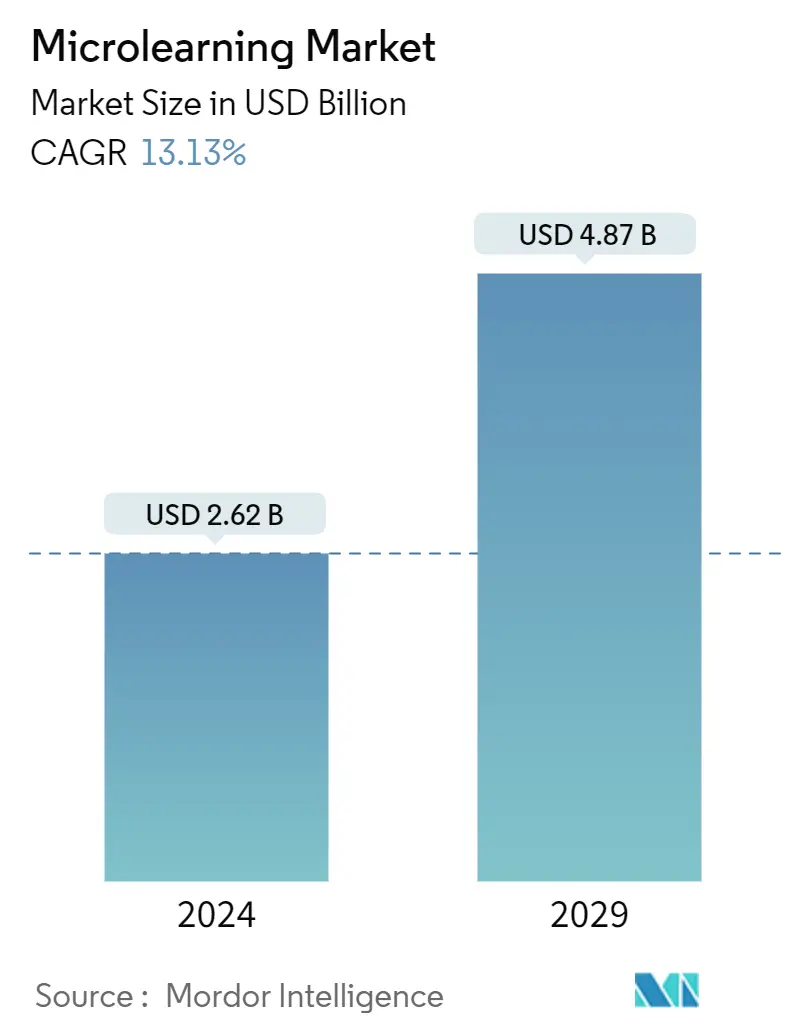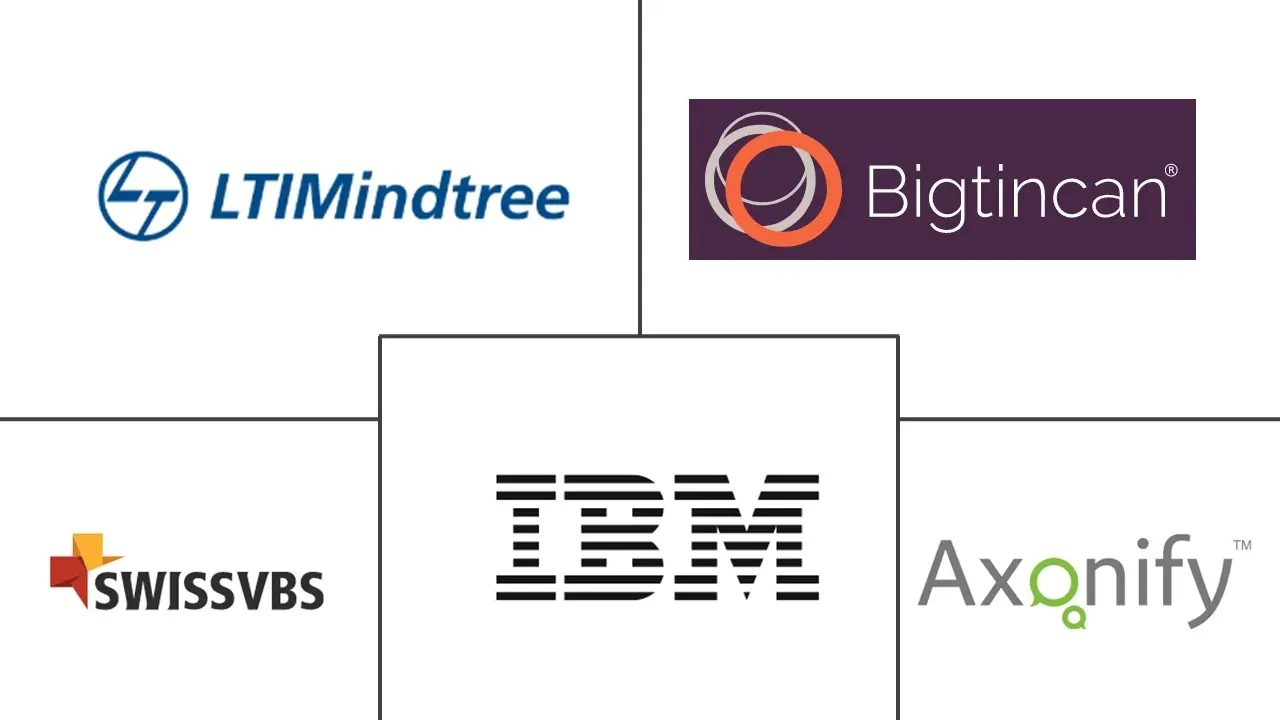Market Size of Microlearning Industry

| Study Period | 2019 - 2029 |
| Market Size (2024) | USD 2.62 Billion |
| Market Size (2029) | USD 4.87 Billion |
| CAGR (2024 - 2029) | 13.13 % |
| Fastest Growing Market | Asia Pacific |
| Largest Market | North America |
| Market Concentration | Medium |
Major Players
*Disclaimer: Major Players sorted in no particular order |
Microlearning Market Analysis
The Microlearning Market size is estimated at USD 2.62 billion in 2024, and is expected to reach USD 4.87 billion by 2029, growing at a CAGR of 13.13% during the forecast period (2024-2029).
- The use of microlearning is rapidly becoming more common across workplaces, homes, and educational institutions. According to the NTL Institute of Applied Behavioral Science Learning Pyramid model, the traditional learning methods based on listening, reading, and observing are ineffective. The person might recall only 20% to 30% of the contents. The advancement in technology based on simulation learning is effectively driving the market's growth, with a high percentage of learning outcomes.
- The need to train mobile workers in numerous global organizations is a crucial element driving the growth of the global microlearning market. Another major market-driving factor is the expansion of the growing need for skill-based and result-oriented training that may give measurable results for businesses.
- Microlearning is a holistic approach toward e-learning that majorly deals with using small learning units to deliver training. Microlearning involves designing bite-sized learning nuggets to help learners acquire and retain knowledge better, each meeting a specific learning outcome. It is a promising learning approach in e-learning because of its several benefits to learners and instructors.
- Also, the increased adoption and availability of cloud-based solutions have been significant drivers for the market. They provide the platform and necessary infrastructure to address the scalability limitation of the traditional on-premise microlearning experiences. Moreover, microlearning has been witnessing an increased implementation in existing applications and platforms, which includes gamification for customer engagement and value creation.
- Furthermore, the growing demand from millennials for higher flexibility and variation of jobs has significantly resulted in a considerable workforce consisting of freelancers changing their positions frequently and working on different projects at different organizations instead of doing routine long-hour jobs. Therefore, these freelancers have become a potential target audience for microlearning solution providers.
- Furthermore, the gamification of training and education to enhance microlearning acceptability will create further opportunities for the microlearning industry to develop. However, a lack of motivation among learners could further challenge the expansion of the microlearning market.
- During the pandemic, several industry verticals used micro-learning approaches to teach their staff about using the latest technology and procedures to run company activities, leading to considerable micro-learning market growth. The micro-learning program helped people acquire new skills by utilizing videos, audio, and the personal experiences of diverse industry experts. COVID-19 provided immense opportunities for microlearning in various end-user industries, and thus, the market will grow in the long run.
Microlearning Industry Segmentation
Microlearning is the process of breaking down employee training into small, bite-sized pieces. The goal is to use short courses that are easy for employees to learn and apply quickly. It offers benefits such as mobile access, limited distraction, just-in-time learning, and actionable content.
The Microlearning Market is segmented by Component (Solution, Services), Organization Size (Large Enterprises, Small and Medium-Sized Enterprises), Deployment Mode (On-Premise, Cloud), End-User (Retail, Manufacturing, Banking, Financial Services, and Insurance, Telecom, and IT) and by Geography.
The market sizes and forecasts are provided in terms of value (in USD) for all the above segments.
| By Component | |
| Solution | |
| Services |
| By Organization Size | |
| Large Enterprises | |
| Small and Medium-Sized Enterprises |
| By Deployment Mode | |
| On-Premise | |
| Cloud |
| By End User | |
| Retail | |
| Manufacturing | |
| Banking, Financial Services and Insurance | |
| Telecom and IT | |
| Other End Users (Healthcare and Life Sciences, Logistics) |
| By Geography | |
| North America | |
| Europe | |
| Asia-Pacific | |
| Rest of the World |
Microlearning Market Size Summary
The microlearning market is experiencing significant growth, driven by the increasing adoption of technology-enhanced learning methods across various sectors, including workplaces, educational institutions, and homes. This approach focuses on delivering training in small, manageable units, which has been shown to improve knowledge retention and learning outcomes. The demand for skill-based and result-oriented training is a major factor propelling the market, as organizations seek to equip their workforce with the necessary skills to meet evolving business needs. The rise of mobile and cloud-based solutions has further facilitated the expansion of microlearning, providing scalable and flexible training options that cater to the needs of a diverse workforce, including freelancers and millennials who prefer varied and flexible job roles.
The North American region holds a significant share of the microlearning market, supported by rapid technological adoption and increased penetration of digital devices. The region's focus on modern learning models, backed by governmental support, is fostering market growth. Gamification is emerging as a key strategy to enhance employee productivity and engagement through interactive and rewarding training experiences. However, the market faces challenges such as a lack of standardized guidelines for gamification and varying levels of learner motivation. The competitive landscape is fragmented, with numerous local and regional players vying for market share, employing strategies like partnerships and acquisitions to enhance their offerings and maintain a competitive edge.
Microlearning Market Size - Table of Contents
-
1. MARKET INSIGHTS
-
1.1 Market Overview
-
1.2 Industry Value Chain Analysis
-
1.3 Industry Attractiveness - Porter's Five Forces Analysis
-
1.3.1 Bargaining Power of Suppliers
-
1.3.2 Bargaining Power of Consumers
-
1.3.3 Threat of New Entrants
-
1.3.4 Threat of Substitutes
-
1.3.5 Intensity of Competitive Rivalry
-
-
1.4 Assessment of Impact of COVID-19 on the Industry
-
-
2. MARKET SEGMENTATION
-
2.1 By Component
-
2.1.1 Solution
-
2.1.2 Services
-
-
2.2 By Organization Size
-
2.2.1 Large Enterprises
-
2.2.2 Small and Medium-Sized Enterprises
-
-
2.3 By Deployment Mode
-
2.3.1 On-Premise
-
2.3.2 Cloud
-
-
2.4 By End User
-
2.4.1 Retail
-
2.4.2 Manufacturing
-
2.4.3 Banking, Financial Services and Insurance
-
2.4.4 Telecom and IT
-
2.4.5 Other End Users (Healthcare and Life Sciences, Logistics)
-
-
2.5 By Geography
-
2.5.1 North America
-
2.5.2 Europe
-
2.5.3 Asia-Pacific
-
2.5.4 Rest of the World
-
-
Microlearning Market Size FAQs
How big is the Microlearning Market?
The Microlearning Market size is expected to reach USD 2.62 billion in 2024 and grow at a CAGR of 13.13% to reach USD 4.87 billion by 2029.
What is the current Microlearning Market size?
In 2024, the Microlearning Market size is expected to reach USD 2.62 billion.

